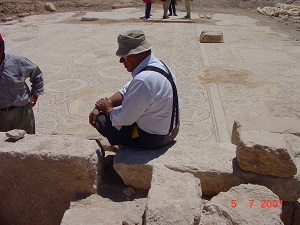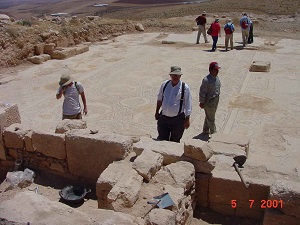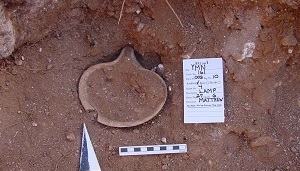Tell Ya’amun 2001 Excavations
Jerome C. Rose
Abdel Halim al-Shiyab
Nizar Turshan
Chuck Hunton
The joint University of Arkansas and Yarmouk University excavations at the site of Ya’amun in Irbid district of north Jordan were conducted between 18 June and 26 July 2001. The Arkansas team comprised Prof. Jerry Rose, Dr. Jeff Mitchem, Dr. Dolores Burke, Mr. Abdulla Alakkam and Ms. Kim Williams. The Yarmouk team comprised Dr. Abdel Halim al-Shiyab, Dr. Nizar Turshan, Mr. Muafaq Battayneh, Mr. Hussein Debajah, Mr. Faris Bdeir, and Mr. Amar Oubeidat. There were 15 American and one Jordanian student participants. The Department of Antiquities was represented by Mr. Salameh Fayyad.
Excavations were conducted at three locations on the site: 1. The Byzantine church located on the eastern portion of the Tell; 2. Structural remains on the northeast rim of the Tell; and Necropolis 3 located across the wadi to the west of the Tell.
Church
Excavations in the church took place in the narthex located in the western portion of the church. Two 5 x 5 meter squares were opened up: F1 and G1. In F1 there is a one meter thick wall running north to south and excavation concentrated on the portion of the square to the east of this wall. Many collapsed stones were removed to reveal two pillars attached to the north-south wall. On the floor there is a stone pavement covering the original mosaic church floor below. There is also a fire place, considerable ash, and a large quantity of lime. The fill contained numerous Byzantine to Ummayyad sherds. Two carved marble columns (107cm long by 15cm square at the base) from the chancel screen were found on the pavement floor neatly placed against the east-west wall.
The next square to the south (G1) shows continuation of the same north-south wall. Here also two pillars for an archway are found attached to the wall. It seems clear that this once was the south entrance into the narthex and aligns with the south entrance into the church. As in F1 the mosaic floor continues with a geometric design. Here against the north-south wall are two large storage jars fixed to the floor with plaster. The lower fill of this square also produced many Byzantine through Ummayyad sherds.
Interpretation of the narthex must remain preliminary, but the evidence suggests extensive modification of the narthex during the Ummayyad period. Two east-west walls were added to divide the narthex into three rooms. The north room, excavated in 2000 seems to have been used for storage. The middle room (F1) was used for a workshop as indicated by the slag, lime, and ash. The vitrified slag and the presence of lime suggests a glass workshop. The south room with storage jars and ash may have been a kitchen area. The doorways from these three rooms into the church had been closed with blocking stones at some time in the past indicating that these rooms were no longer in use while the main portion of the church experienced continued utilization in some, as yet, unknown way. The rebuilding of the north south wall with unshaped stones on top of the shaped stones of the original church indicates that much of the had deteriorated prior to its modification during the Ummayyad period.
Tell
The discovery of Bronze Age tombs in 1999 prompted a surface survey of the adjacent tell and confirmed the presence of extensive Bronze Age occupations. A robber pit exposed some standing walls in the perimeter of the northeast corner of the tell and here two 5 x 5 meter squares were opened in 2000 and continued in the 2001 excavations which have revealed a complex of rooms of which only one room and a circular storage pit were completely excavated. Room 2 was excavated to their bedrock foundation leaving walls standing 1.5 meters high. The doorway into this room and an adjacent room had been sealed with blocking stones in the past. There are two architectural phases to this structure. The earliest phase includes the walls built on bedrock and containing two doors. These structures appear to date to the Late Middle Bronze or Early Late Bronze and will be more securely dated when final attributions of the scarab and cylinder seal are made. The second phase consists of more massive but less meticulously constructed walls that are built on and cross cut the earlier phase walls. This phase may date to the Late Bronze/Early Iron I period. The total sherd count for this year’s excavation in square 2A21 that reached bedrock is 28% Middle Bronze and 70% Late Bronze Age. The loci closest to the wall foundations are 49% Middle Bronze and 51% Late Bronze and the lowest locus is 100% Late Bronze. These rooms are located on the lowest point of the Tell and clearly filled with slope wash and sherd content from the higher western and southern portions of the Tell. Secure dating must await scarab and seal attributions.
The objects to date indicate extensive trade involving the small site of Ya’amun. Mycenaean and Cypriot ceramic sherds are abundant in the Bronze Age tombs and to a lesser extent on the tell. The Egyptian scarabs and a Mittanian cylinder seal also indicate trade. The data from the tombs excavated in 1999 and 2001 complement the data derived from these structures on the Tell. The cleared standing walls are at least 1.5 meters high suggesting we will find an extensive Bronze Age settlement on the tell.
An exploratory trench on the east side of the Tell revealed walls of at least three rooms with standing walls of at least one meter that can be dated to the Ayyubid/Mamluk period.
Tombs
A total of ten possible tombs were identified for excavation in the extensively robbed Necropolis 3.
Tomb 157 is only a possible Bronze Age tomb as it could also be a small natural cave, but the smooth flat floor belies this. There were few sherds or bones found and nothing further will be known about this feature.
Tomb 158 is a roughly circular tomb with collapsed roof and evidence for robbing in modern times. The tomb was either a natural cavern or roughly cut for use as a tomb. The presence of an articulated skeleton and associate scarab resting on top of a consolidated gray rocky fill and within a tan fill indicates that the structure was partly filled with the gray material to provide a flat surface and that the bedrock was not used as the tomb floor. The tomb produced 6,135 sherds of which 22% are Middle Bronze and 78% Late Bronze. In addition to more than 40kg of fragmented human bone the one articulated skeleton is of a 23-25 year old male. The three scarabs will eventually provide a firmer date and do indicate contact with Egyptians who did control this area at that time. The 265 objects include toggle pins, carved bone fragments, beads, hair pins, earring, bracelet, juglets, and lamps and lamp fragments numbering 137 from both the Middle and Late Bronze Ages.
Tomb 159 is a horizontal chamber tomb with three roughly cut loculi. The entire front of the tomb had completely caved off leaving the entire tomb opened up to 1.5 meters behind the original entrance. The roughly cut loculi are short and the presence of subadult teeth and bones suggest that they had been used for children. There were two limestone sarcophagi present. A complete Late Roman lamb was found wedged beside and partly under one sarcophagus that had escaped the tomb robbers and provides a date for construction of the tomb.
Tomb 160 is a shallow vertical shaft tomb with a side chamber for one individual. This robbed tomb is very roughly cut and may never have been finished and used. It is directly in line with tomb 163 which is of the same type but nicely finished.
Tomb 161 appears as a very irregular depression or eroded area in the bedrock, but the presence of complete lams and a jug belies this interpretation. The sherd counts are 11% Middle Bronze and 88% Late Bronze.
Tomb 163 is a shallow vertical shaft tomb with both a bottom and side burial chambers fitted with shelves for laying the closing slabs. Unlike Tomb 160 with which it lines up, this one is finished and the presence of the broken covering slabs indicates that it was used and robbed in modern times. The tomb type is similar to one from Necropolis 1 and by type dates to the Late Roman – Byzantine times.
Tomb 165 was a roughly circular tomb with a collapsed roof and evidence for robbing in modern times. There is clear evidence for a door into the tomb in the south wall. Numerous small blue faience beads found in a single location means that not all of the tomb was completely disturbed by robbers. The sherd count is 53% Middle Bronze and 46% Late Bronze. A cylinder seal will provide a firmer date when attribution is available.


